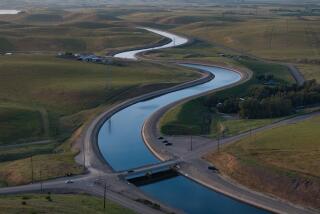Under new EPA rule, Clean Water Act protections will cover all active tributaries
The Obama administration finalized new regulations Wednesday that it says will protect streams, rivers and wetlands that provide drinking water to more than 117 million Americans.
The Clean Water Rule, drafted by the Environmental Protection Agency and the Army Corps of Engineers, extends the Clean Water Act’s protections to all tributaries with signs of flowing water. These streams and wetlands can have a crucial effect on the health of downstream waters, agency officials say. For “drinking water to be clean, the streams and wetlands that feed them need to be clean too,” EPA Administrator Gina McCarthy said in a statement.
Environmental groups applauded the changes, which have been opposed by farm groups, land developers and others who warned they would extend federal regulations onto inland wetlands and ponds that go well beyond the traditional scope of federal oversight .
“President Obama heeded the call of sound science and public input in finalizing this rule,” Erich Pica, president of Friends of the Earth, an environmental advocacy group, said in a statement.
The Sierra Club also backed the new rule. “We think this is an easy decision for anyone who is not in the pocket of big polluters,” Executive Director Michael Brune said in a statement.
The new regulations are due to take effect 60 days after publication, but critics in Congress have vowed to block them, and opponents have said they are planning litigation to challenge many of their provisions.
The American Farm Bureau, in a letter to Congress, said the new regulations created confusion and risk by providing too much authority to regulate a variety of areas where rainwater collects.
Republicans in Congress also have expressed concerns. “The administration’s decree to unilaterally expand federal authority is a raw and tyrannical power grab that will crush jobs,” House Speaker John A. Boehner of Ohio said in a statement.
The administration said the move was designed to clarify ambiguities in the Clean Water Act. The uncertainty stems from a 2006 Supreme Court decision that concluded the act protects against illegal discharges into streams and wetlands that connect to navigable waters, but that did not define what qualified as a connection.
Before the new rule, up to 60% of American streams and millions of acres of wetlands were potentially overlooked by the Clean Water Act, EPA officials say. One in three Americans and more than 90% of Los Angeles County residents use drinking water affected by these sources that lacked clear protection from pollution before the rule change, according to the agency.
The new regulations are expected to have a significant effect in California.
They will provide full protection for the first time, for example, to a network of vernal pools that lie along much of the coast. While the Los Angeles River fell under the jurisdiction of the Clean Water Act, its tributaries are now also covered.
The new rule as adopted appears to alleviate many of the concerns expressed by California water agencies that the regulations would impose overly broad restrictions over agricultural ditches, stormwater retention basins, recycled water centers and constructed wetlands. Most of those waterways, EPA officials said, are not covered in the final rule.
But Kari Fisher, an environmental attorney for the California Farm Bureau Federation, said the organization was studying the new rule to make sure.
“We … remain concerned with the rule and its potential impact on California farmers and ranchers. As [originally] proposed, the rule would have improperly extended federal regulation to isolated waters such as puddles and ditches, and it would have regulated land use under the guise of regulating water,” she said in a statement.
She said the group had not yet had time to determine how extensively the final rule differed from what was initially proposed. “Unless there are fundamental changes, we’ll remain opposed. We continue to support efforts in Congress to overturn the rule,” she said.
@katemshepherd
More to Read
Start your day right
Sign up for Essential California for news, features and recommendations from the L.A. Times and beyond in your inbox six days a week.
You may occasionally receive promotional content from the Los Angeles Times.






